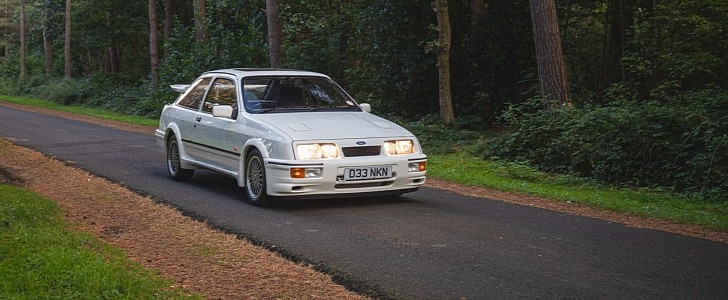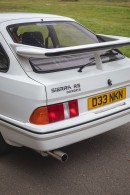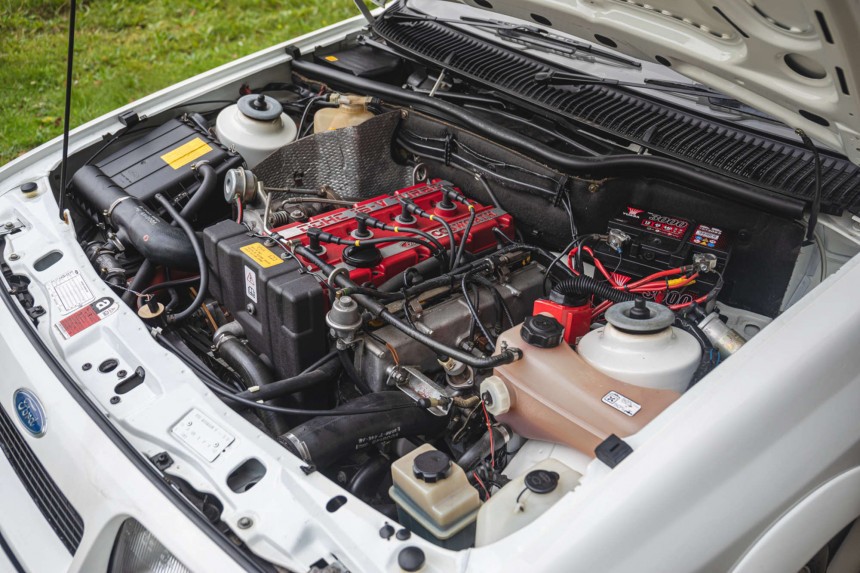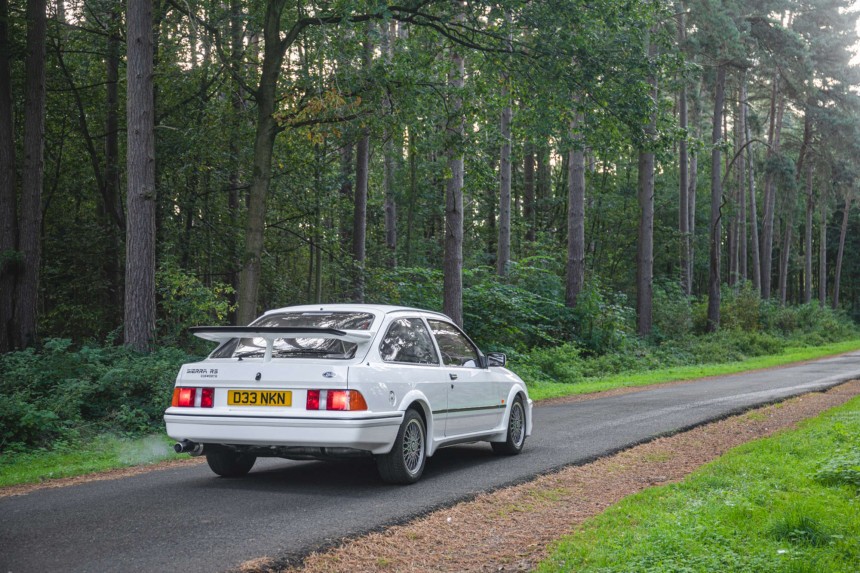One of the automotive industry’s most successful collaborations, Ford and Cosworth went bananas in the 1980s thanks to Stuart Turner. Anointed big kahuna of European Motor Sports in 1983, this gentleman convinced Ford’s high-ranking execs to approve two homologation specials: the mid-engined RS200 and the front-engined Cossie we’ll cover in this story.
The Sierra was chosen as the starting point for the Ford Motor Company’s Group A touring car for two reasons. First and foremost, the Dearborn-based automaker initially had trouble selling the rear-wheel-driven model. And secondly, the aerodynamic design would pay dividends in Group A.
Cosworth, the company that developed the DFV engine with Ford’s backing, was contracted for the powerplant of the Cossie. The British engineering company had to modify the Sierra’s existing 2.0-liter mill for this application, a job they accepted with one string attached. Specifically, Cosworth told Ford they had to place an advance order for 15,000 units of the new engine.
Ford was initially terrified by this prospect because Group A regulations mandated 5,000 cars produced within a year. But as you already know by now, the Ford Motor Company accepted Cosworth’s offer because they were hungry for success. On that note, let’s get a little bit more technical.
Codenamed T88, the Pinto block that serves as the basis for the YBB in the legendary hot hatchback displaces 1,993 cubic centimeters. One of the biggest changes brought by Cosworth is the alloy head, which rocks two camshafts that operate 35-mm intake valves and 31-mm exhaust valves.
Gifted with a 90.8-mm bore and a 76.95-mm stroke, this powerplant is further gifted with Mahle pistons, forged steel connecting rods, a high-flow oil pump, a cast aluminum sump, a forged steel crankshaft, and a less restrictive exhaust system. Another tremendous change over the 2.0-liter unit in the Sierra is the 0.7-bar turbocharger, namely a Garrett AiResearch T03B.
Weber Marelli engine management, electronic fuel injection, and a compression ratio of 8.0:1 also need to be mentioned. We also have to remember the YBB is the very first series-production car engine to surpass 100 horsepower per liter. More specifically, Ford quoted 201 horsepower at 6,000 revolutions per minute and 204 pound-feet (277 Nm) at 4,500 rpm.
Now imagine what kind of grunt a mid-engined V8 supercar from the Prancing Horse of Maranello was capable of in 1985 when the Sierra RS Cosworth was revealed in full at the Geneva Motor Show. To be frank, the lyrical waxing in the automotive media of that era wasn’t just hyperbole.
Given the output figures of this force-fed lump, the Blue Oval decided on a five-speed transmission shared with the Mustang. The BorgWarner T5 was understandably beefed up for this application. Spruced up with a quicker steering rack than the Sierra, the Cossie also boasts firmer dampers, stiffer coil springs, thick anti-roll bars, and ABS developed in collaboration with ATE. Ventilated rotors with four-piston calipers are present up front while the rear wheels are fitted with solid brake rotors and single-piston brake calipers.
Riding on 15- by 7.0-inch alloys mounted with Dunlop rubber shoes, the Sierra RS Cosworth puts the power down to the rear wheels with the help of a limited-slip differential of the viscous-coupling variety. Constructed from steel and fiberglass, this fellow features a very recognizable rear spoiler.
Originally envisioned with a triple-decker layout, the rear spoiler was inspired by the Red Baron’s plane according to Frank Stephenson. The Moroccan-born American designer explains that Ford’s bean counters voted against it.
Frank Stephenson states that “the finance guy’s argument was that if we got rid of the middle wing, we would probably be saving about five Deutsche Marks on the design and bill of materials. And so, that won over, unfortunately. That always felt for me like a big loss in terms of design. It’s still considered one of the iconic designs of the ‘80s, but for me, it always felt like this was a child that had been born with nine fingers instead of ten.”
Even with a two-wing layout, the rear spoiler increased the vehicle’s drag coefficient to 0.345 thanks to more downforce over the rear axle. Offered in standard Diamond White, the Cossie was available in Black or Moonstone Blue at extra cost. No fewer than 5,042 examples of the Sierra RS Cosworth were produced through January 1987, of which 2,616 were delivered in the United Kingdom. Never offered in the U.S. of A., the Sierra RS Cosworth was immediately followed by the limited-production Sierra RS500 Cosworth.
500 cars were sent to engineering company Tickford, of which 394 were finished in black. The engine in the RHD-only RS500 is codenamed YBD and cranks out 224 horsepower. The subsequent Sierra Sapphire RS Cosworth takes its mojo from the original YBB whereas the Sierra Sapphire RS Cosworth 4x4 was offered with two mills: the catted YBG and non-catted YBJ.
Cosworth, the company that developed the DFV engine with Ford’s backing, was contracted for the powerplant of the Cossie. The British engineering company had to modify the Sierra’s existing 2.0-liter mill for this application, a job they accepted with one string attached. Specifically, Cosworth told Ford they had to place an advance order for 15,000 units of the new engine.
Ford was initially terrified by this prospect because Group A regulations mandated 5,000 cars produced within a year. But as you already know by now, the Ford Motor Company accepted Cosworth’s offer because they were hungry for success. On that note, let’s get a little bit more technical.
Codenamed T88, the Pinto block that serves as the basis for the YBB in the legendary hot hatchback displaces 1,993 cubic centimeters. One of the biggest changes brought by Cosworth is the alloy head, which rocks two camshafts that operate 35-mm intake valves and 31-mm exhaust valves.
Weber Marelli engine management, electronic fuel injection, and a compression ratio of 8.0:1 also need to be mentioned. We also have to remember the YBB is the very first series-production car engine to surpass 100 horsepower per liter. More specifically, Ford quoted 201 horsepower at 6,000 revolutions per minute and 204 pound-feet (277 Nm) at 4,500 rpm.
Now imagine what kind of grunt a mid-engined V8 supercar from the Prancing Horse of Maranello was capable of in 1985 when the Sierra RS Cosworth was revealed in full at the Geneva Motor Show. To be frank, the lyrical waxing in the automotive media of that era wasn’t just hyperbole.
Given the output figures of this force-fed lump, the Blue Oval decided on a five-speed transmission shared with the Mustang. The BorgWarner T5 was understandably beefed up for this application. Spruced up with a quicker steering rack than the Sierra, the Cossie also boasts firmer dampers, stiffer coil springs, thick anti-roll bars, and ABS developed in collaboration with ATE. Ventilated rotors with four-piston calipers are present up front while the rear wheels are fitted with solid brake rotors and single-piston brake calipers.
Originally envisioned with a triple-decker layout, the rear spoiler was inspired by the Red Baron’s plane according to Frank Stephenson. The Moroccan-born American designer explains that Ford’s bean counters voted against it.
Frank Stephenson states that “the finance guy’s argument was that if we got rid of the middle wing, we would probably be saving about five Deutsche Marks on the design and bill of materials. And so, that won over, unfortunately. That always felt for me like a big loss in terms of design. It’s still considered one of the iconic designs of the ‘80s, but for me, it always felt like this was a child that had been born with nine fingers instead of ten.”
Even with a two-wing layout, the rear spoiler increased the vehicle’s drag coefficient to 0.345 thanks to more downforce over the rear axle. Offered in standard Diamond White, the Cossie was available in Black or Moonstone Blue at extra cost. No fewer than 5,042 examples of the Sierra RS Cosworth were produced through January 1987, of which 2,616 were delivered in the United Kingdom. Never offered in the U.S. of A., the Sierra RS Cosworth was immediately followed by the limited-production Sierra RS500 Cosworth.
500 cars were sent to engineering company Tickford, of which 394 were finished in black. The engine in the RHD-only RS500 is codenamed YBD and cranks out 224 horsepower. The subsequent Sierra Sapphire RS Cosworth takes its mojo from the original YBB whereas the Sierra Sapphire RS Cosworth 4x4 was offered with two mills: the catted YBG and non-catted YBJ.






























































